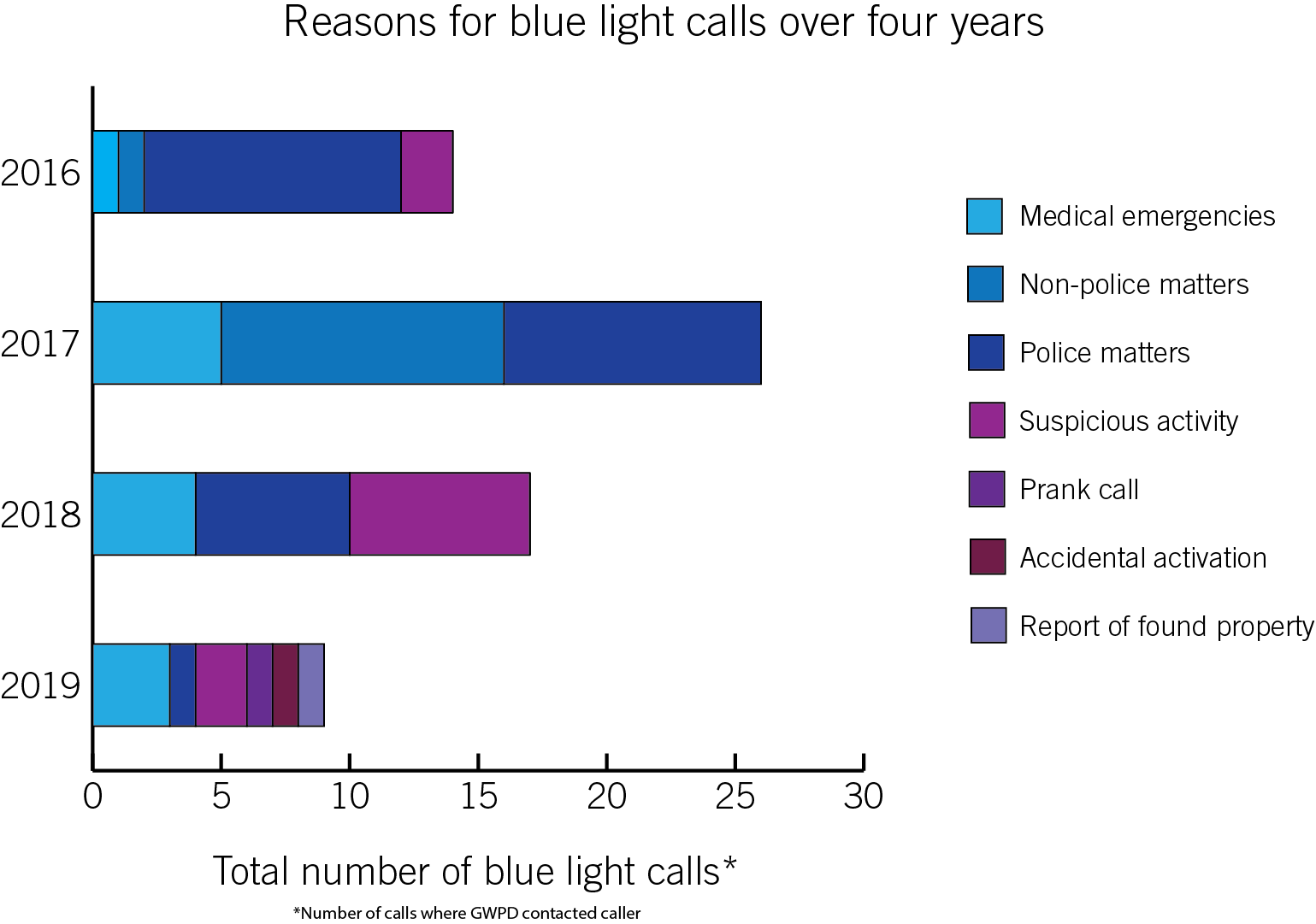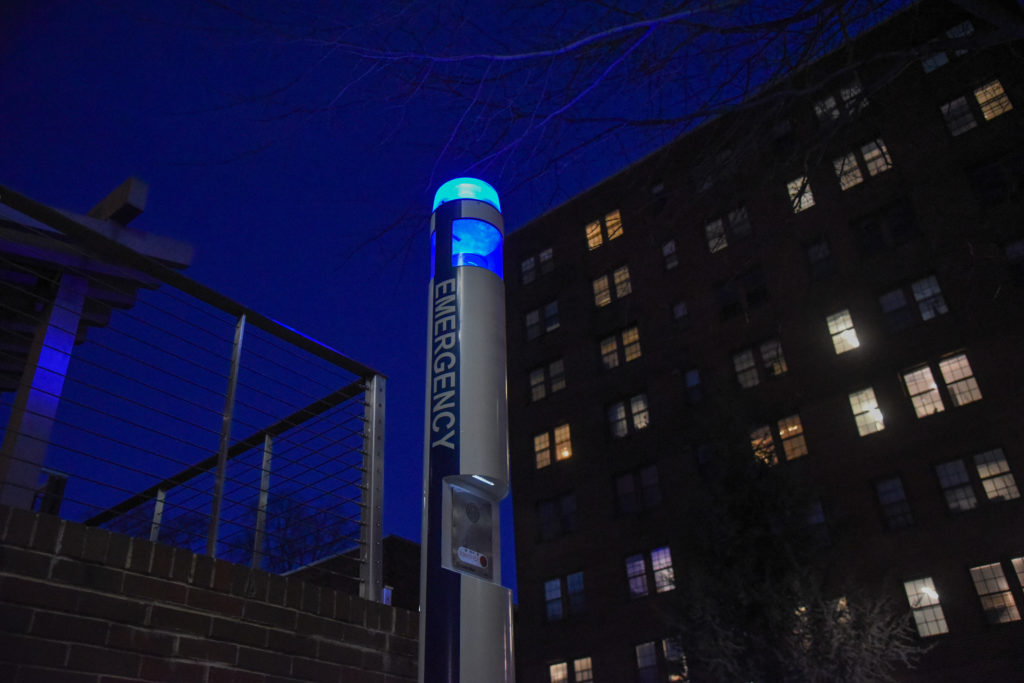Updated: Jan. 13, 2020 at 11:45 p.m.
Blue light emergency phone use on campus decreased by nearly 20 percent between 2018 and 2019, according to GW Police Department data.
In 2019, GWPD officers received 173 calls from on-campus blue light stations, of which officers made contact with the caller nine times, the data shows. In interviews, more than 10 students said they’ve never needed to use blue lights, but knowing the phones can be used to call emergency services makes them feel secure while walking around campus.
Mary Paradis, the former interim chief of police, said blue light callers rarely made contact with police officers because callers typically leave the area before officers arrive. GWPD officers did not make contact with nearly 90 percent of all blue light calls since 2016.
“It is not as important for students to use them as it is for students to be aware that we have these phones and to be aware of their location,” Paradis said in an email. “Blue light phones are strategically placed around campus as a means to connect the community with GWPD.”
GWPD received 110 blue light voice calls in 2016, but GWPD only made voice contact with the caller on 23, or about 20 percent, of the calls. In 2017, the department received 228 calls and 26 callers made contact with the caller, about an 11 percent increase from the previous year, according to GWPD data.

Alyssa Illaria | Graphics Editor
Paradis said the University added “several” blue light phones to campus in 2017, which likely caused the spike in calls that year.
She said GWPD more frequently responds to blue light calls than to the calls made from the PAL app, which allows users to text or call GWPD about an emergency and tracks the user’s location using GPS. Paradis said the University will begin transitioning to a new “app-based” security system this spring.
“The vast majority of our calls for service are through our emergency telephone line,” she said. “Calling the GWPD emergency line allows you to interface with dispatchers and provide the most detailed information about the emergency.”
Eleven students said they’ve never used a blue light phone but feel safer knowing that the phones are a back-up option to calling emergency services.
Senior Jennifer Nwokolo said the blue light phones make her feel secure on campus, but she doesn’t know if they’re functional or not because she’s never used one.
“If something were to happen and there’s no resort, it’s good to know that they’re there,” she said.
Freshman Danielle Shakib said her roommate used a blue light recently because she felt unsafe when she was walking home late at night.
“She pushed the button, but somebody was there to help her right away and walk her home, so it was no big deal,” she said.
Freshman Ryan Shiwoo-Kim said the blue light phones and GW’s other security services, like Safe Ride and consistent GWPD patrols, contribute to his overall sense of security on campus.
“It’s great that it is there for people who might need it,” he said. “And I feel like it is placed strategically around campus. So it’s definitely accessible.”
Campus security experts said college students typically opt to call emergency services on their own cell phones, but the blue light is a secure option for students to use in the case of an emergency.
Marc Lovicott, the director of communications for the University of Wisconsin-Madison Police Department, said an “overwhelming majority” of his department’s blue light activations are generally accidental or prank calls.
“They are very underutilized technology,” Lovicott said. “Now, that is not to say that we’re looking into getting rid of the blue light phones. We see them as a good thing on our campus, and it provides a sense of security to our campus as well.”
Lovicott said blue light phones are meant to help students who don’t carry cell phones with them or whose cell phones break or need to be charged.
“Most people carry a cell phone,” he said. “That’s probably the number one way they’ll reach our department, but we also like to have these around in places that are a little more desolate, and it brings a sense of security to individuals as well,” he said.
Gary Sigrist Jr., the CEO of the campus security company Safeguard Risk Solutions, said the drop in blue light use doesn’t mean the University should phase the system out because the phones still contribute to campus safety as a whole.
“Everything is a layered approach, and so those blue lights are just one layer,” he said. “If there were four emergencies that they responded to where they helped somebody, that’s a good thing.”
John Vinson, the president of the International Association of Campus Law Enforcement Administrators, said blue lights are a single part of a security portfolio that universities employ in addition to security apps and an emergency phone number.
“Every institution, university and/or community college has to decide what works best for their respective community to ensure that no matter what the issue or concerns are, around perceived and or real crime or safety concerns, their community has a variety of ways to contact them,” Vinson said.
Kateryna Stepanenko and Lia DeGroot contributed reporting.
This post has been updated to correct the following:
The Hatchet incorrectly reported the name of the association John Vinson leads. The name is now correct. We regret this error.





